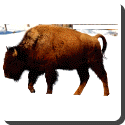 Bison — Bison is a taxonomic group containing six species of large even-toed ungulates within the subfamily Bovinae. Only two of these species still exist: the American Bison (B. bison) and the European Bison, or wisent (B. bonasus).
Bison — Bison is a taxonomic group containing six species of large even-toed ungulates within the subfamily Bovinae. Only two of these species still exist: the American Bison (B. bison) and the European Bison, or wisent (B. bonasus).
The American and European bison are the largest terrestrial mammals in North America and Europe. Like their cattle relatives, bison are nomadic grazers and travel in herds, except for the non-dominant bulls, which travel alone or in small groups during most of the year. American bison are known for living in the Great Plains. Both species were hunted close to extinction during the 19th and 20th centuries but have since rebounded, although the European bison is still endangered.
Unlike the Asian Water Buffalo, the bison has never really been domesticated, although it does appear on farms occasionally. It is raised now mostly on large ranches in the United States and Canada for meat. Wild herds are found in Yellowstone, Utah’s Antelope Island, South Dakota’s Custer State Park, Alaska, and northern central Canada .
Bison live to be about 20 years old and are born without their trademark “hump” or horns. With the development of their horns, they become mature at two to three years of age, although the males continue to grow slowly to about age seven. Adult bulls express a high degree of dominance competitiveness during mating season.
 Kids Portal For Parents India Kids Network
Kids Portal For Parents India Kids Network






